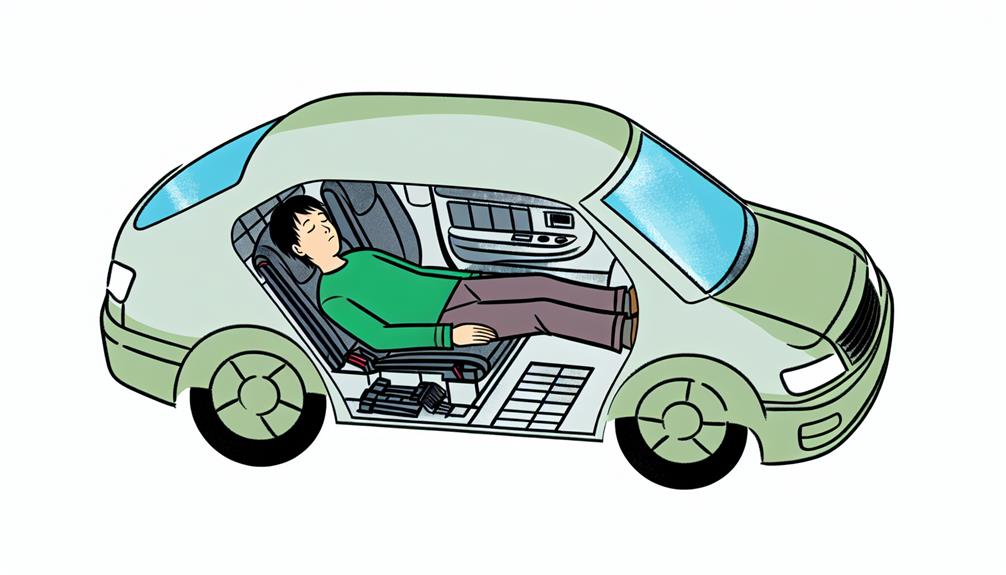Proper ventilation is often overlooked when it comes to sleeping in a car, yet its importance cannot be understated. The risks associated with inadequate airflow during sleep are not to be dismissed lightly.
Understanding how to optimize ventilation in such confined spaces can make a significant difference in both comfort and safety. As we explore the dynamics of sleeping in a car, it becomes evident that ventilation plays a crucial role in ensuring a restful and secure rest.
Key Takeaways
- Ventilation is crucial for safe and healthy sleep in a car.
- Poor airflow can lead to discomfort, health issues, and fatigue.
- Enhance ventilation by opening windows slightly or using car vents.
- Prioritize airflow to prevent carbon dioxide buildup and ensure a restful sleep.
Importance of Ventilation in Car Sleeping
Proper ventilation is a critical factor to consider when sleeping in a car to ensure a safe and comfortable environment. Adequate air circulation is essential to maintaining a healthy sleep environment inside a vehicle. When parked for the night, the lack of proper ventilation can lead to a buildup of carbon dioxide from your breath and other pollutants within the confined space of the car. This can result in poor air quality, leading to discomfort, headaches, and even more severe health issues over time.
To enhance the sleep environment in a car, it is crucial to ensure that there is sufficient airflow. Opening windows slightly or using car vents can help promote better air circulation. Additionally, installing a small battery-operated fan can further improve ventilation inside the vehicle, aiding in maintaining a fresh supply of oxygen and reducing the risk of inhaling harmful substances. Prioritizing ventilation while sleeping in a car is vital for creating a safe and comfortable atmosphere conducive to rest and overall well-being.
Risks of Poor Airflow While Sleeping
Insufficient airflow during sleep in a car can heighten the risk of respiratory issues and discomfort due to the accumulation of carbon dioxide and other pollutants within the confined space. This lack of proper ventilation can lead to potential dangers and various health implications for individuals spending extended periods sleeping in their vehicles. The table below outlines some of the key risks associated with poor airflow while sleeping in a car:
| Potential Dangers of Poor Airflow While Sleeping | Health Implications |
|---|---|
| Increased carbon dioxide levels | Respiratory issues |
| Build-up of pollutants | Discomfort |
| Higher risk of overheating | Headaches |
| Limited oxygen supply | Fatigue |
| Condensation on windows | Allergies |
These factors underscore the importance of ensuring adequate ventilation when sleeping in a car to mitigate these health risks and promote a safer sleeping environment.
Ways to Improve Ventilation in Car
Enhancing airflow in a vehicle during sleep is crucial for maintaining optimal air quality and reducing the risk of respiratory issues and discomfort associated with poor ventilation. To improve ventilation in a car, consider the following:
- Window Screens: Installing window screens allows you to keep windows partially open for fresh air circulation while keeping insects and debris out. This simple solution can significantly enhance airflow without compromising safety or privacy.
- Roof Vent: Adding a roof vent or utilizing the existing one, if available, can greatly improve ventilation by creating a pathway for hot air to escape and cool air to enter. Roof vents are especially effective in promoting air circulation in compact sleeping spaces within vehicles.
- Utilize Cross Ventilation: Strategically opening windows on opposite sides of the vehicle can create a cross breeze, maximizing airflow throughout the interior. This method helps prevent stagnant air pockets and promotes a more comfortable sleeping environment with improved ventilation.
Best Practices for Sleeping Comfort
Implementing strategic positioning and utilizing ergonomic accessories can significantly enhance the quality of sleep experienced while resting in a car. When it comes to sleeping positions, choosing one that supports the natural alignment of your spine is crucial. Optimal sleeping positions in a car include reclining the seat slightly back with adequate neck support to prevent stiffness. Additionally, using cushions or pillows to fill gaps and support your lower back can improve overall comfort.
Temperature control is another essential factor for sleeping comfort in a car. Ensuring proper ventilation by cracking windows slightly can help regulate airflow and prevent the interior from becoming stuffy. In colder conditions, using insulated blankets or a sleeping bag rated for lower temperatures can help retain body heat and promote warmth throughout the night.
Conclusion: Ensuring Safe and Restful Sleep
To ensure safe and restful sleep while sleeping in a car, it is imperative to prioritize proper ventilation and temperature control. Achieving an optimal sleep environment in a car involves considering factors such as air quality and ventilation systems. Here are three key considerations to ensure a safe and restful sleep:
- Sleep Environment: Creating a sleep-conducive environment in your car involves ensuring adequate airflow to maintain good air quality. Poor air quality can lead to discomfort and health issues, affecting the overall sleep experience.
- Ventilation: Proper ventilation not only helps regulate the temperature inside the car but also plays a crucial role in maintaining good air circulation. This, in turn, can have significant health benefits by reducing the risk of condensation, mold growth, and stuffiness.
- Health Benefits: Prioritizing ventilation when sleeping in a car can lead to improved respiratory health, better sleep quality, and overall well-being. By allowing fresh air to circulate, you can enhance your sleep environment and promote a more restful experience.
Frequently Asked Questions
Can Sleeping in a Car Without Proper Ventilation Lead to Carbon Monoxide Poisoning?
Sleeping in a car without proper ventilation can indeed lead to carbon monoxide poisoning. The risks can be mitigated by ensuring effective ventilation systems are in place to prevent the buildup of this deadly gas.
Are There Specific Types of Cars That Are Better Suited for Sleeping In, in Terms of Ventilation?
Selecting the best vehicles for sleep entails a consideration of optimal airflow options. Cars with built-in ventilation systems or those with ample windows for cross-ventilation may offer improved comfort and safety during rest periods.
How Does the Weather or Climate Affect the Need for Ventilation While Sleeping in a Car?
Weather conditions play a crucial role in determining the need for ventilation while sleeping in a car. Temperature regulation is vital to ensure comfort and safety, especially in extreme hot or cold climates, where proper airflow is essential.
Are There Any Portable Ventilation Options Available for Car Sleeping?
When exploring portable ventilation options for car sleeping, individuals may consider utilizing devices such as portable fans or air purifiers. Additionally, window vents or roof vents can provide efficient airflow and help maintain a comfortable sleeping environment.
What Are the Potential Health Risks Associated With Sleeping in a Poorly Ventilated Car?
Poorly ventilated car interiors can lead to poor air quality, affecting sleep patterns and comfort levels. This can result in health risks such as respiratory issues, headaches, and fatigue. Proper ventilation is crucial for a restful and safe sleep environment.
Conclusion
In conclusion, it is imperative to prioritize ventilation when sleeping in a car to mitigate potential health risks associated with poor airflow.
By ensuring proper airflow, individuals can enhance their sleeping comfort and overall well-being during rest periods in their vehicles.
As the saying goes, 'better safe than sorry,' taking proactive measures to improve ventilation in car sleeping environments is essential for a safe and restful experience.

